英语学习策略与技巧教程教师用书unit3
初中英语九年级上册(牛津译林版)Unit3Studyskills教学设计
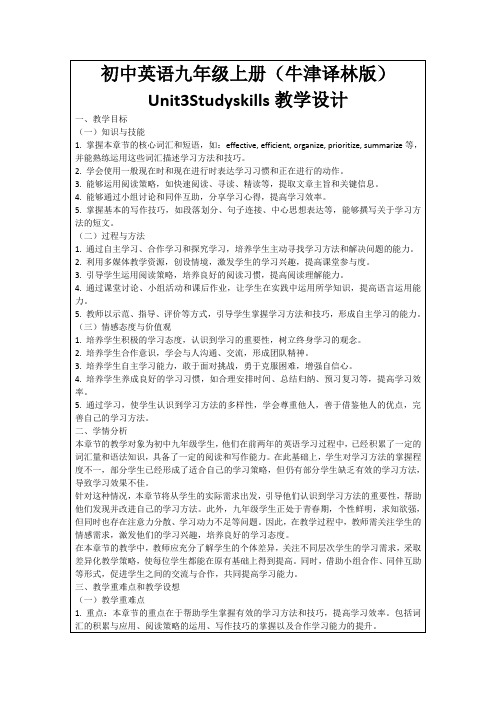
1.培养学生积极的学习态度,认识到学习的重要性,树立终身学习的观念。
2.培养学生合作意识,学会与人沟通、交流,形成团队精神。
3.培养学生自主学习能力,敢于面对挑战,勇于克服困难,增强自信心。
4.培养学生养成良好的学习习惯,如合理安排时间、总结归纳、预习复习等,提高学习效率。
5.通过学习,使学生认识到学习方法的多样性,学会尊重他人,善于借鉴他人的优点,完善自己的学习方法。
3.阅读策略:教师引导学生运用阅读策略,如快速阅读、寻读、精读等,对文章进行深入理解,提取关键信息。
(三)学生小组讨论
1.教学活动:学生分成小组,讨论以下问题:“你们认为自己的学习方法有效吗?为什么?请分享一种你认为最有效的学习方法。”
2.小组分享:各小组代表汇报讨论成果,其他小组成员进行补充。
3.教师点评:教师针对各小组的分享进行点评,提炼出有效的学习方法,并对学生的表现给予肯定。
二、学情分析
本章节的教学对象为初中九年级学生,他们在前两年的英语学习过程中,已经积累了一定的词汇量和语法知识,具备了一定的阅读和写作能力。在此基础上,学生对学习方法的掌握程度不一,部分学生已经形成了适合自己的学习策略,但仍有部分学生缺乏有效的学习方法,导致学习效果不佳。
针对这种情况,本章节将从学生的实际需求出发,引导他们认识到学习方法的重要性,帮助他们发现并改进自己的学习方法。此外,九年级学生正处于青春期,个性鲜明,求知欲强,但同时也存在注意力分散、学习动力不足等问题。因此,在教学过程中,教师需关注学生的情感需求,激发他们的学习兴趣,培养良好的学习态度。
四、教学内容与过程
(一)导入新课
1.教学活动:教师展示一组学习方法的图片,如“合理安排时间”、“做好笔记”、“积极参与课堂”等,引导学生关注学习方法的重要性。
英语学习策略与技巧教程教师用书
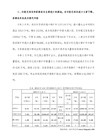
9. If you are still in the process of learning the L2, you may not yet possess a wide repertoire
reflected the theory that the teacher was imparting knowledge to the learners who
were only sitting there passively waiting to receive it. Later on, the student-centered
single type. In fact there are some elements of each type in the overall task of L2 learning.
The skill-learning elements are apparent. We usually say a competent competence
vocabulary, and grammar. For another, we should have some knowledge about the L2
system.
3. In middle school English learning, there are many practices which can be traced back to
For example, we may learn to ride a bicycle, swim, dance, play volleyball, conduct a class,
Unit2 Lesson 3 Thinking Skills Reading Strategies

3
1
2
visit grandparents
play basketball
cook
How can we organize these ideas into a text?
Activity 1
Look at the pictures and read the text. Learn how to organize ideas.
What’s the text about?
A.Some students’ school life.
B.Some students’ study.
C.Some students’ free-time activities.
D.Some students’ homework.
It’s a Sunday morning. Mary doesn’t need to go to school. She says to her mum, “I need some clothes. Can we go to Nice Girls’ Clothes Shop?”
3. go shopping 购物,去买东西
go v. 意为“去,走”,其反义词为:come, 常用于“go to+地点名词”或“go+地点副词”结构。 “go +动词-ing” 意为“去做某事”, 表示从事某项活动或运动。类似的短语还有:
go climbing 去爬山
_go swimming__ 去游泳
Be able to get the main idea and key points quickly when reading a text.
新课讲授 A writer needs to think of some ideas first, and then organize them in a good way. Put the pictures in the right order and describe the pictures.
高三英语语言学习策略(PPT)3-3

1.确定需要学习的材料 2.把材料分门别类 3.反复接触材料 4.采取措施记忆材料
1.语言提取策略 2.语言演练策略 3.弥补策学习策略是学习者自己构造并直接作用于学 习过程、旨在促进学习者语言系统发展的策略。
5. Oxford (1989):语言学习策略是学习者为了使语言学习更 成功、更有目的、更愉快而采取的行为或行动。
属茄属 亚 属龙葵亚属 种 马铃薯 分布区域 亚洲、北美、非洲南部和澳大利亚 营养成分 等维生素C、蛋白质、糖类 英文名 potato 目录 名称由来 历史起源 形态特征 ? 植株形态 ? 块茎形态 生长习性 ? 生长周期 ? 生长条件 品种分类 产量分布 ? 世界 ? 中国 毒性 ? 中毒原因 ? 中毒症状 ? 急救措施 ? 预防措施 8 繁殖栽培技术 ? 品种选择 ? 选地;跨境留学 跨境留学 ;及整地 ? 种薯处理 ? 播种 ? 施肥 ? 水分管理 ? 中耕管理 ? 收获 病害防治 ? 晚疫病 ? 病毒病 ? 环腐病 虫害防治 ? 斑潜蝇 ? 蚜虫 ? 蛴螬 ? 地老虎 主要价值 ? 营养价值 ? 经济价值 ? 用及保健价值 ? 工业价值 土豆皮变绿后能不能食 用 名称由来 “马铃薯”因酷似马铃铛而得名,此称呼最早见于康熙年间的《 马铃薯 马铃薯 松溪县志食货》。中国东北、河北称土豆,华北称山蛋,西北和
强,现已遍布世界各地,热带和亚热带国家甚至在冬季或凉爽季节也可栽培并获得较高产量。由于马铃薯非常适合在原来粮食产量极低,只能生长莜麦(裸 燕麦)的高寒地区生长,很快在内蒙古、河北、山西、陕西北部普及,马铃薯和玉米、番薯
Cohen (1998)的语言学习策略分类框架
第二语言学习者策略
语言学习策略
语言使用策略
两湖地区称洋芋,江浙一带称洋番芋或洋山芋,广东称之为薯仔,粤东一带称荷兰薯,闽东地区则称之为番仔薯,在鄂西北一带被称为“土豆”。 [] 英语 potato来自西班牙语patata。据西班牙皇家学院称,此西班牙词汇由泰依诺语batata(红薯)和克丘亚语papa(马铃薯)混合而来的。在拉丁美洲,“马铃薯” 的西班牙语用papa一词。 [] 历史起源 马铃薯原产于南美洲安第斯山区,人工栽培史最早可追溯到公元前8年到年的秘鲁南部地区。世纪中期,马铃薯被一个 西班牙殖民者从南美洲带到欧洲。那时人们总是欣赏它的花朵美丽,把它当作装饰品。 [] 8年英国人在加勒比海击败西班牙人,从南美搜集烟草等植物种子, 把马铃薯带到英国,英国的气候适合马铃薯的生长,比其它谷物产量高且易于管理。 [] 后来一位法国农学家——安·奥巴曼奇在长期观察和亲身实中,发现马 铃薯不仅能吃,还可以做面包等。从此,法国农民便开始大面积种植马铃薯。 [] 世纪时,马铃薯已经成为欧洲的重要粮食作物并且已经传播到中国,马铃薯 传入中国只有三百多年的历史。据说是华侨从东南亚一带引进的,在世纪中国马铃薯种植面积居世界第二位。马铃薯产量高,营养丰富,对环境的适应性较
人教版九年级英语全册Unit3(SectionA1a2c)教学设计
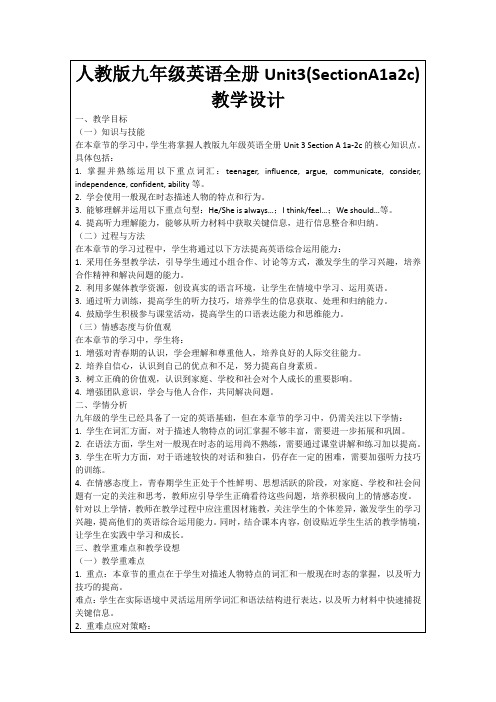
2.利用多媒体教学资源,创设真实的语言环境,让学生在情境中学习、运用英语。
3.通过听力训练,提高学生的听力技巧,培养学生的信息获取、处理和归纳能力。
4.鼓励学生积极参与课堂活动,提高学生的口语表达能力和思维能力。
2.针对一般现在时态,教师通过示例和练习,帮助学生掌握其用法,并强调其在描述人物特点和行为中的应用。
3.学生跟随教师一起分析对话中的句子结构和语法特点,理解并模仿表达方式。
(三)学生小组讨论(500字)
1.教师将学生分成小组,每组选择一个青春期问题进行讨论,如“如何应对来自父母的压力?”。
2.学生运用所学词汇和一般现在时态,进行讨论和表达。
3.教师根据学生的回答,总结青春期常见的问题,如peer pressure、parental expectations、self-esteem等,为新课的学习做好铺垫。
(二)讲授新知(500字)
1.教师呈现Unit 3 Section A 1a-1d的对话内容,引导学生学习ce、argue等。
3.听力作业:完成课后听力练习2d,并记录答案。
目标:提高学生的听力理解能力,巩固所学词汇。
4.阅读作业:阅读一篇关于青春期问题的英文文章,并完成相关阅读理解练习。
要求:选择难易适中的文章,关注文章中的词汇和语法现象,提高阅读理解能力。
5.自主学习作业:学生利用课后时间,总结本节课所学词汇和语法,制作成学习卡片。
1.教师引导学生回顾本节课所学内容,总结青春期问题的特点和解决方法。
2.学生分享自己在课堂中的收获,包括词汇、语法和听力技巧方面的进步。
3.教师强调学习英语的重要性,鼓励学生在日常生活中多加运用,不断提高英语综合运用能力。
2024年译林版英语三年级上册Unit3教案备课
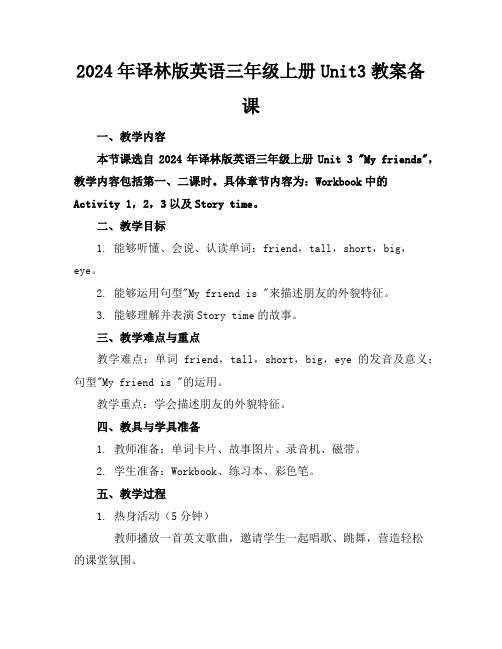
2024年译林版英语三年级上册Unit3教案备课一、教学内容本节课选自2024年译林版英语三年级上册Unit 3 "My friends",教学内容包括第一、二课时。
具体章节内容为:Workbook中的Activity 1,2,3以及Story time。
二、教学目标1. 能够听懂、会说、认读单词:friend,tall,short,big,eye。
2. 能够运用句型"My friend is "来描述朋友的外貌特征。
3. 能够理解并表演Story time的故事。
三、教学难点与重点教学难点:单词friend,tall,short,big,eye的发音及意义;句型"My friend is "的运用。
教学重点:学会描述朋友的外貌特征。
四、教具与学具准备1. 教师准备:单词卡片、故事图片、录音机、磁带。
2. 学生准备:Workbook、练习本、彩色笔。
五、教学过程1. 热身活动(5分钟)教师播放一首英文歌曲,邀请学生一起唱歌、跳舞,营造轻松的课堂氛围。
2. 实践情景引入(5分钟)教师展示一张自己和朋友的照片,引导学生用英语描述照片中的人物外貌。
3. 新课内容呈现(15分钟)(1)教师展示单词卡片,引导学生认读单词:friend,tall,short,big,eye。
(2)教师用句型"My friend is "描述朋友的外貌,让学生模仿并练习。
4. 例题讲解(10分钟)教师选取Workbook中的Activity 1和2,带领学生一起完成,并讲解答案。
5. 随堂练习(10分钟)学生两人一组,根据Workbook中的Activity 3,互相描述对方的外貌。
6. Story time(10分钟)(1)教师播放Story time的录音,让学生跟读。
(2)学生分组,表演Story time的故事。
教师邀请学生分享本节课学到的知识,并进行点评。
仁爱新教材U1L3 Thinking Skills and Reading Strategies
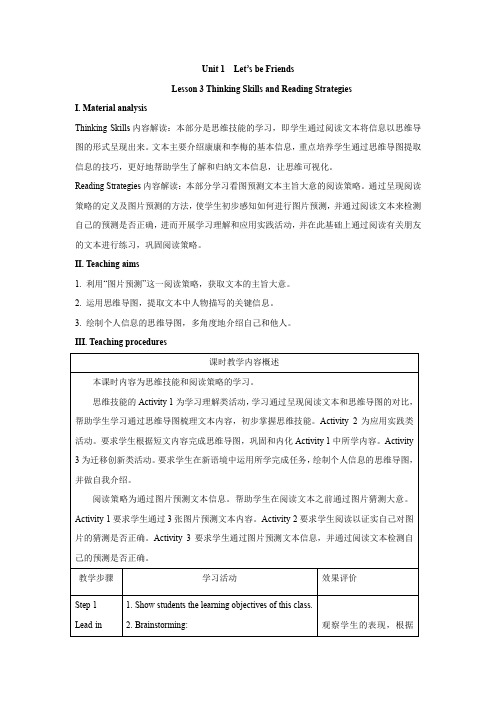
Unit 1 Let’s be Friends
Lesson 3 Thinking Skills and Reading Strategies
I. Material analysis
Thinking Skills内容解读:本部分是思维技能的学习,即学生通过阅读文本将信息以思维导图的形式呈现出来。
文本主要介绍康康和李梅的基本信息,重点培养学生通过思维导图提取信息的技巧,更好地帮助学生了解和归纳文本信息,让思维可视化。
Reading Strategies内容解读:本部分学习看图预测文本主旨大意的阅读策略。
通过呈现阅读策略的定义及图片预测的方法,使学生初步感知如何进行图片预测,并通过阅读文本来检测自己的预测是否正确,进而开展学习理解和应用实践活动,并在此基础上通过阅读有关朋友的文本进行练习,巩固阅读策略。
II. Teaching aims
1. 利用“图片预测”这一阅读策略,获取文本的主旨大意。
2. 运用思维导图,提取文本中人物描写的关键信息。
3. 绘制个人信息的思维导图,多角度地介绍自己和他人。
III. Teaching procedures
IV. Blackboard design。
英语学习策略与技巧教程教师用书unit3

英语学习策略与技巧教程教师用书unit3Unit 3 Learner AutonomyAims and ObjectivesAfter learning this unit, the students should know:1. what is learner autonomy,2. what are its features,3. what are the ways to promote leaner autonomy.Tasks1. The most important difference between teacher-directed learning and independentlearning is:In the former, you do not have to have an overall plan for your learning. The teacherwill do this for you. For example, the teacher will work out such things as the purpose oflearning, the method of learning, the timetable, the problems to overcome trouble to beshot, and so on.In the latter, you have to be responsible for the whole learning process yourself. Youshould consider your purpose, the methods to be adopted, the amount of time to be spenton it per week, the problems trouble you would overcome come across in the course oflearning, the way out, etc.2. Autonomous learners have the following features. They1) have insights into their learning styles and strategies;2) take an active approach to the learning task at hand;3) are willing to take risks, i.e., to communicate in the targetlanguage at all costs;4) are good guessers;5) attend to form as well as to content, and pay attention to that is, place importance onaccuracy as well as appropriacy;6) develop the target language into a separate reference system and are willing to reviseand reject hypotheses and rules that do not apply; and7) have a tolerant tolerance of and outgoing approach to the target language and itsculture.3. It is generally agreed that L2 learners should develop learner autonomy. Languagelearning is such a complex and enormous project. It is also time-consuming. Even ifclassroom learning is available to you, it is impossible for the teacher to teach everythingyou need for your ultimate goal is such a complex system that it is impossible to exhausta portion of it. In this connection, the learner should be able to learn on their ownthemselves to expand the limit of classroom learning.What‘s more, independent learners will also develop independent personality. Theytend to be able to cope with other problems independently. This is an important qualityfor L2 learner to communicate in L2 because autonomous learners are faster in adaptingthemselves to the new role of L2 users in different communicative situations.4. Among others, you should consider the following questions:1) What benefits and drawbacks learning a second language could have in general.2) What benefits and drawbacks learning a particular language could have.3) What the nature of language and language learning is.4) What are the language elements, if any, that need to be le arned regardless of one‘spurpose, and to what degree.5) For the purpose of one‘s study, what elements of the language need to be learnedand to what degree.6) In what order these elements could be learned.7) How these elements could be learned.8) How much time it would normally take to learn a particular element.9) How objectives can be set and study plans made.10) What the necessary resources are and where they are available.11) What kind of language learner you are and how you learn.12) How the learning of a particular item can be evaluated as you learn and after youhave learned.13) What your strengths are in learning L2 in question.14) What your weaknesses are in learning L2 in question.15) How much time you are prepared to spend on your language learning per week.16) What resources you will need.17) What kind of support you will need.18) How you will keep your motivation up.Etc.5. Careful consideration of these questions helps you be more aware of your need. Thereforeyou will be a more conscious and efficient learner if you do as you are required in thistask.6. By considering the criteria, you may know what is the proper way to plan and write acomposition and eventually try to write it in a proper way.7. It is important for you to have the interview questions ready beforehand with regard to thetask performed.8. There is no hard and fast answer to this task.9. There is no hard and fast answer to this task.Home AssignmentThe assignment is to engage students to experience learning as an autonomous learner. Bysurfing on the internet, they will have a better understanding of how to be an autonomouslearner and how to learn on their own. Let the students do it themselves.Some hints for L2 teachers to encourage learner autonomy The following list includes practical tips one could consider using when trying to developlearner autonomy in the future.1. Encourage students to be interdependent and to work collectively. The less studentsdepend on their teacher the more autonomy is beingdeveloped. Many students likeworking in small groups and usually can be placed in pairs or small groups for variousexercises quite easily, that is, not against their wills. Pairs and groups can read dialoguestogether, do information-gap activities and consult each other on the meaning andclarification of the task at hand.2. Ask students to keep a diary of their learning experiences. Through practice, studentsmay become more aware of their learning preferences and start to think of new ways ofbecoming more independent learners. Diary entries could be written after every lesson sothat students can record their sentiments about it. Students could also record whether ornot they thought they benefited from what they did and give reasons why or why not.After they record their experiences for a month or two, teachers could help their studentsinterpret their experiences and give them additional techniques to suit their learningstyles.3. Explain teacher/student roles from the outset. As well, asking students to give theiropinions on the issue of roles could be beneficial. However, their prior experiences maynot match the type of environment you wish to foster. Thus, while the eventual goal isindependence/interdependence (see point 4, below), theinitial outcome of discussion onroles may not result in a fully-developed notion of an independent learner. It would beprofitable to set aside time at various points throughout the academic year so that theseroles may be reassessed as students' feelings of independence grow. Emphasis could alsobe given to learning about the target language and its social contexts of use. Learningabout autonomy may be something the students are hearing for the first time and somemight react negatively to it. Therefore, learning about learner autonomy should beintroduced gradually over time (see point 4) as the students experience its benefits.Teachers could mention cultural differences in the beginning of courses to outline whatthe students will be doing in class, and suggest to them that they may be doing somethingdifferent from what they may be used to. Also, having a discussion regarding how Englishconversation differs from other subjects could be beneficial. For example, teachers couldask the students if learning English is similar to History or Math, where it is common tolisten to lectures about information and theory, or if learning English is similar to playingthe piano or baseball where it is common to practice and be active.4. Progress gradually from interdependence toindependence. Give the students time toadjust to new learning strategies and do not expect too much too soon. Start thedevelopment of learner autonomy from larger groups, then work towards smaller groups,pairs, and finally individuals. Also, start courses by giving the students fewer choicesconcerning their learning and work towards many choices, and finally freer choices, suchas open-ended tasks, or allowing students to make their choices entirely on their own.5. Give the students projects to do outside the classroom. Such projects may increasemotivation. For example, set up a pen-pal writing exchange program with a foreignschool, or have the students do interviews with foreigners they happen to meet. Outsideprojects are important for most students learning English because most students spend solittle time in class or language lab. For those serious about learning English, out-of-classtime is the only way they are going to study enough to make much of a difference.6. Give the students non-lesson classroom duties to perform (taking roll, writinginstructions, notices, etc. on the board for the teacher). But do this only if it is done inEnglish and there is adequate time.7. Have the students design lessons or materials to be used in class. Also do an "interestsand ability" inventory at the beginning of every school year so you can understand how totailor your lessons. Time could be set aside at the end of the course for practical criticismof study tasks and textbooks used in the course. More student control over themanagement of learning resources could be encouraged as well.8. Instruct students on how to use the school's resource centres: the school library, thelanguage lab, and the language lounge. Teachers could encourage the students to join theschool's English Club. Explain everything about the resource centres, taking nothing forgranted. Have a lesson centred on using the various resources. Work with the people incharge of the resources to get their full cooperation and support.9. Emphasize the importance of peer-editing, corrections, and follow-up questioning inthe classroom. Inform the students that feedback from their peers can be valuable in thatthey can become more aware of their language mistakes, including grammar errors andvocabulary misuse. Using follow-up questions not only among classmates but also withtheir teacher can facilitate learning and higher levels of awareness and understanding ofthe target language.10. Encourage the students to use only English in class. Tellthe students that this is a greatchance for them to use only English, and few opportunities like this exist for them. Part ofthe role of the language teacher is to create an environment where students feel theyshould communicate in the target language and feel comfortable doing so. Heavy relianceon the students' native language may side-track efforts to reach optimal levels of thetarget language in the classroom. Students could be introduced to ways of greeting eachother and starting and maintaining conversations.11. Stress fluency rather than accuracy. Therefore, emphasize communication and thenegotiable and interpretive aspects of English conversation. Students need not constantlyover-concern themselves with correct grammar and vocabulary usage and accuracy.Students should be encouraged to use dictionaries sparingly and to try as best they can notto use erasers while taking notes, writing in diaries or journals, or doing writing exercises,including compositions. Much more information could be conveyed and absorbed ifstudents spent less time worrying about their language accuracy.12. Allow the students to use reference books, including dictionaries (preferablyEnglish-English), in class. Not to contradict the previous tip, provided students do not usethese aids too often or fall into the "accuracy is more important than fluency" fallacy, theycan develop autonomy and independence by looking up information and meanings ontheir own, in pairs, or in groups.。
人教版九年级英语全册教学设计:Unit3SectionB

3.学生跟随教师朗读课文,注意语音语调,理解文章内容。
4.教师引导学生关注文章中关于人物描述的表达方式,总结句型和语法结构,提高学生的阅读理解能力。
(三)学生小组讨论
1.教师将学生分成小组,每组选择一个人物,讨论并记录该人物的成就、经历和特点。
1.部分学生对英语学习缺乏兴趣,课堂参与度不高,影响学习效果。
2.学生的阅读理解能力有待提高,对文章深层含义的把握和推理判断能力不足。
3.口语表达能力有限,缺乏自信,不敢在公共场合用英语表达自己的观点。
4.写作能力较弱,句子结构单一,篇章组织能力不足。
针对以上学情,本章节的教学应注重激发学生的学习兴趣,提高课堂参与度;加强阅读训练,提高学生的阅读理解能力;创设口语表达机会,培养学生的自信心;设计多样化的写作任务,提高学生的篇章组织能力。同时,关注学生的个体差异,因材施教,使每个学生都能在原有基础上得到提高。
4.针对写作能力的提高,采用以下教学策略:
a.设计不同类型的写作任务,如日记、书信、故事等,让学生在实践中提高写作能力。
b.引导学生关注篇章结构,学会使用过渡词和连接词,使文章条理清晰。
c.举办写作讲座,教授写作技巧,提学生的写作水平。
d.开展互评、小组评等活动,让学生在评价他人作品的过程中,学习借鉴优点,改进自身不足。
3.教师播放一段与本节课主题相关的短视频,激发学生的兴趣,引导学生关注本节课的核心词汇和句型。
4.通过提问方式,引导学生预测本节课的学习内容,为新课的学习做好铺垫。
(二)讲授新知
1.教师带领学生学习和复习与本节课相关的词汇和短语,如confident, perform, talented, achieve, overcome等,通过图片、实物等辅助教学,帮助学生形象记忆。
四年级英语学习策略与教学实践:Unit3教案解析
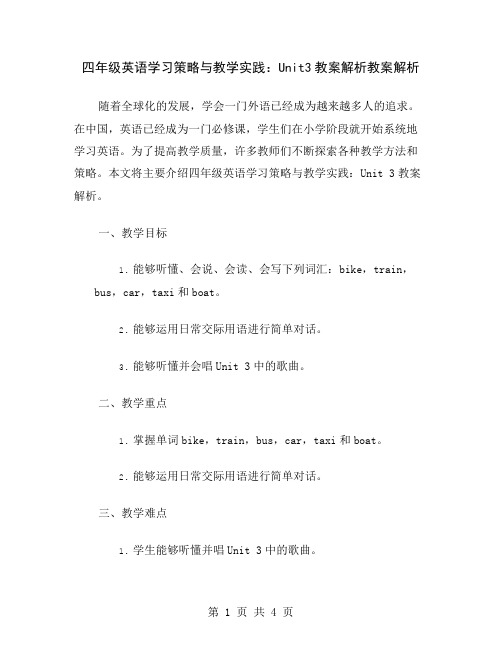
四年级英语学习策略与教学实践:Unit3教案解析教案解析随着全球化的发展,学会一门外语已经成为越来越多人的追求。
在中国,英语已经成为一门必修课,学生们在小学阶段就开始系统地学习英语。
为了提高教学质量,许多教师们不断探索各种教学方法和策略。
本文将主要介绍四年级英语学习策略与教学实践:Unit 3教案解析。
一、教学目标1.能够听懂、会说、会读、会写下列词汇:bike,train,bus,car,taxi和boat。
2.能够运用日常交际用语进行简单对话。
3.能够听懂并会唱Unit 3中的歌曲。
二、教学重点1.掌握单词bike,train,bus,car,taxi和boat。
2.能够运用日常交际用语进行简单对话。
三、教学难点1.学生能够听懂并唱Unit 3中的歌曲。
2.学生能够熟练地使用日常交际用语进行对话。
四、教学方法1.情境教学法通过模拟真实情境来进行教学,使学生更加深入地了解实际应用场景,从而提高学习兴趣和积极性。
2.游戏教学法通过游戏的方式来进行教学,既能够使学生愉悦地学习,也能够在潜移默化中增强学生的记忆力和理解能力。
五、教学内容及实施过程1.导入(1)Show Time教师播放一段有关交通工具的视频,让学生们尽量多地说出视频中所涉及的交通工具,调动学生们的自主思考及表达能力。
(2)Guess Time教师将一些常见交通工具的图片贴在黑板上,让学生们看一眼后,将图片遮住,让学生们看一看现在显示的图片,从中猜出自己记得什么。
2.新课程呈现与讲解(1)Listen and Find教师为学生们播放交通工具的歌曲,引导学生们跟着歌词找出和歌词对应的交通工具图片,并进行相应的发音练习,从而掌握词汇bike,train,bus,car,taxi和boat。
(2)Look and Say教师在黑板上给出一些图片,进行小组教学,让学生在小组内互相提问、回答,模拟日常生活中的简单对话交流,从而熟练掌握日常交际用语。
初中英语七年级下册(牛津译林版)Unit3Studyskills教学设计

-合作学习:培养学生的团队协作能力,通过小组合作完成任务。
(三)情感态度与价值观
1.情感目标:通过本单元的学习,使学生形成以下情感态度:
-热爱学习:认识到学习的重要性,培养积极的学习态度。
-自信:在学习过程中,相信自己能够克服困难,不断提高。
-合作:学会与他人合作,共同解决问题。
2.提出问题:向学生提问:“How do you study for tests?”、“How do you spend your time after school?”,让学生思考自己的学习方法及时间安排。
3.小组讨论:让学生分组讨论以下话题:分享自己的学习方法和时间管理技巧,讨论在学习过程中遇到的问题和困难。
4.引入新课:根据学生的讨论,引出本单元的主题——Study skills,告诉学生我们将学习如何更有效地安排学习时间和提高学习效率。
(二)ቤተ መጻሕፍቲ ባይዱ授新知
1.词汇教学:
-通过图片、例句等形式,呈现本单元的重点词汇,如effective, efficient, goal, schedule等。
-引导学生用新学的词汇描述学习场景,加强词汇运用能力。
1.词汇练习:完成课后词汇练习题,包括填空、选择、匹配等题型,要求学生在规定时间内完成,以检验对重点词汇的掌握程度。
2.语法练习:结合一般现在时和现在进行时,完成语法练习题,让学生在实际语境中运用两种时态,提高语法运用能力。
3.情景对话:编写一个关于学习方法或时间管理的情景对话,要求使用本单元所学词汇和语法,对话内容要具有实际意义。
2.梳理学习方法和时间管理技巧:引导学生总结课堂上学到的学习方法,如何合理安排学习时间,提高学习效率。
Unit 3 (E英语教程(第二版)教师用书 4
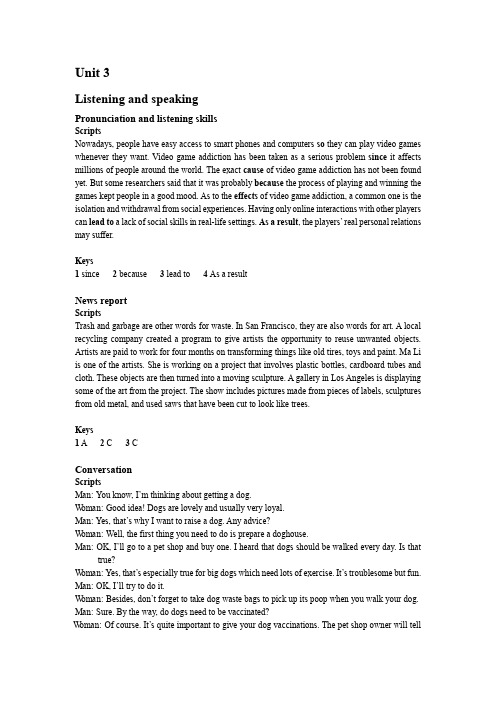
Unit 3Listening and speakingPronunciation and listening skillsScriptsNowadays, people have easy access to smart phones and computers so they can play video games whenever they want. Video game addiction has been taken as a serious problem since it affects millions of people around the world. The exact cause of video game addiction has not been found yet. But some researchers said that it was probably because the process of playing and winning the games kept people in a good mood. As to the effects of video game addiction, a common one is the isolation and withdrawal from social experiences. Having only online interactions with other players can lead to a lack of social skills in real-life settings. As a result, the players’ real personal relations may suffer.Keys1 since2 because3 lead to4 As a resultNews reportScriptsTrash and garbage are other words for waste. In San Francisco, they are also words for art. A local recycling company created a program to give artists the opportunity to reuse unwanted objects. Artists are paid to work for four months on transforming things like old tires, toys and paint. Ma Li is one of the artists. She is working on a project that involves plastic bottles, cardboard tubes and cloth. These objects are then turned into a moving sculpture. A gallery in Los Angeles is displaying some of the art from the project. The show includes pictures made from pieces of labels, sculptures from old metal, and used saws that have been cut to look like trees.Keys1 A2 C3 CConversationScriptsMan: You know, I’m thinking about getting a dog.Woman: Good idea! Dogs are lovely and usually very loyal.Man:Yes, that’s why I want to raise a dog. Any advice?Woman: Well, the first thing you need to do is prepare a doghouse.Man:OK, I’ll go to a pet shop and buy one. I heard that dogs should be walked every day. Is that true?Woman: Yes, that’s especially true for big dogs which need lots of exercise. It’s troublesome but fun. Man:OK, I’ll try to do it.Woman:Besides, don’t forget to take dog waste bags to pick up its poop when you walk your dog. Man: Sure. By the way, do dogs need to be vaccinated?Woman: Of course. It’s quite important to give your dog vaccinations. The pet shop owner will tellyou where to have it done.Man: I see. Thanks for your advice!Keys11 T2 F3 T4 T21 the first thing you need to do2don’t forget to3It’s quite important to3S ample conversationsSituation 1Alex: Hi, Sam. I find it difficult to keep fit.Sam: Why do you say that?Alex: Although I often do physical exercise, it is not easy to stay in shape. Could you please give me some advice?Sam: Sure. The first thing you need to do is try to make a practical plan according to your own needs. Second, choose the right amount and intensity of exercise. Last but not least, stick to your plan.Alex: OK. What else do I need to do?Sam: A healthy lifestyle is also very important, like getting enough sleep and having a balanced diet. Alex: I see. Thanks a lot!Situation 2Mary:It seems that I’m a plant killer. I like having plants in my room, but I find it difficult to grow them.Kate: What happened?Mary: I have tried to grow many kinds of plants, but they all died in the end.Kate: No matter how much care and attention you give to plants, they aren’t going to thrive if you don’t know their specific needs. Asparagus fern (文竹), for example, likes shade. You’d better not put it in the sun for too long.Mary: You are right. Do you have other suggestions?Kate:Make sure the pot you are using is big enough. Plants need room to grow. Don’t forget to water the plants only as often as needed. Watering too little or too much will kill the plants. Mary:I’ve never thought about that. Thanks for your great suggestions.PassageScriptsDo you know angelfish? They are one of the most brightly colored fishes in the sea, and people like to keep them as pets because of the elaborate patterns on their bodies. It’s always enjoyable to see them swimming. The Bellus Angelfish is one of the types which can be raised at home as pets. Theycan be kept in male-female pairs or live in small groups. It is OK to have a number of female fish in each group, but there should be only one male fish in it. This is because male fish may fight with other males. Perhaps the most interesting thing about Bellus Angelfish is that they are one of the few angelfish that can change from female to male! The change happens for a specific reason. If the male fish dies or disappears, the leading female angelfish in the group begins to change both of her gender and appearance. And, about two weeks later, the change can be complete!Keys11 T2 F3 F4 T21 D2 B3 B3(略)ReadingPassage ALanguage points1. I was recently involved in a debate concerning the topic of how many people appear to make value judgments on art based on knowledge of the artist’s personality, beliefs, and life choices. (Para. 1)be involved in: to do things and be part of an activity or event 参加……;参与……e.g. The financier was involved in a number of projects in his hometown.concerning:prep. about or relating to 关于e.g. We have several questions concerning the report.value judgment:n. a decision or judgment about how good something is, based on opinions not facts 价值判断e.g. I’m not going to make a value judgment about her lifestyle.knowledge: n. the fact that you know that something is happening 知道;了解e.g. The staff had no knowledge that the company was in trouble.2. It made me think, “Does the personal life of an artist play a part in how we view his or her artwork for better or for worse?” (Para. 1)play a part / role in (doing) sth.: if sth. plays a part in sth., it is one of the several causes that make it happen or be successful 起作用;有影响e.g. This innovation has played a part in the company’s success.for better or (for) worse: used for showing that you do not know whether an action, situation, or change will have good or bad results 不论好坏;不管怎样e.g. I decided to follow her advice, for better or (for) worse.3. Sometimes it does seem that people critique art solely on what they know about the artist in question instead of focusing on the art itself. (Para. 2)critique:v. to judge whether sb. or sth. is good or bad 评论e.g. Afterwards, the rest of the group will critique your presentation.solely:ad. only, and not involving anyone or anything else 仅仅地;唯一地;单独地e.g. I shall hold you solely responsible for anything that goes wrong.in question: the person, thing, time, etc. in question is the one that you are talking about 所提到的;正在谈论的e.g. The photograph in question was taken long before I met you.4. The same can be said about Pablo Picasso regarding the volatile relationships he had. (Para. 2)regarding:prep. about or relating to 关于;至于;就……而论e.g. He refused to tell us any information regarding the man’s address.volatile: a. a volatile situation is likely to change suddenly and without much warning 易变的;动荡不定的e.g. People are afraid to change jobs in today’s volatile economy.5. … would people experience strong emotions when viewing his paintings if they were not aware of his struggles and suicide? (Para. 2)[Note] 该句使用了虚拟语气,表示文中所述的是与现在事实不符的假设。
北师大版英语九年级全一册:Lesson 3 Language Learning Tips. 教案设计
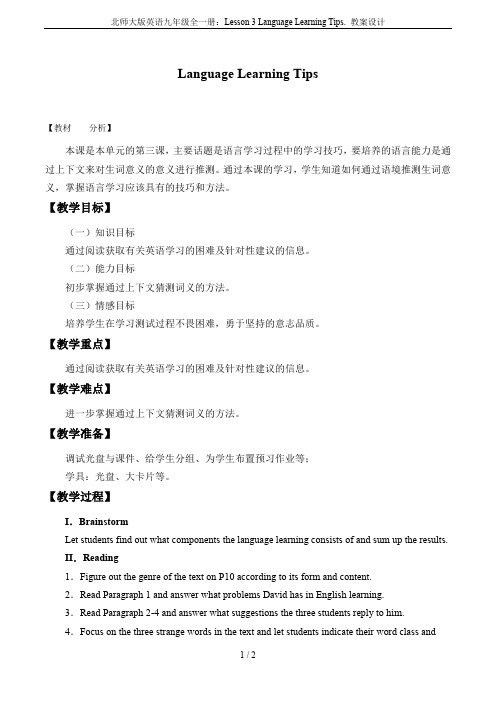
Language Learning Tips【教材分析】本课是本单元的第三课,主要话题是语言学习过程中的学习技巧,要培养的语言能力是通过上下文来对生词意义的意义进行推测。
通过本课的学习,学生知道如何通过语境推测生词意义,掌握语言学习应该具有的技巧和方法。
【教学目标】(一)知识目标通过阅读获取有关英语学习的困难及针对性建议的信息。
(二)能力目标初步掌握通过上下文猜测词义的方法。
(三)情感目标培养学生在学习测试过程不畏困难,勇于坚持的意志品质。
【教学重点】通过阅读获取有关英语学习的困难及针对性建议的信息。
【教学难点】进一步掌握通过上下文猜测词义的方法。
【教学准备】调试光盘与课件、给学生分组、为学生布置预习作业等;学具:光盘、大卡片等。
【教学过程】I.BrainstormLet students find out what components the language learning consists of and sum up the results.II.Reading1.Figure out the genre of the text on P10 according to its form and content.2.Read Paragraph 1 and answer what problems David has in English learning.3.Read Paragraph 2-4 and answer what suggestions the three students reply to him.4.Focus on the three strange words in the text and let students indicate their word class andcontexts.5.Guess the meaning according to the context.6.Read the text again and fill in the table in Exercise 3.III.Guessing1.Read the passage in Exercise 6 and pay attention to the context of the underlined words 2.Guess the meaning of the underlined words according to the context.IV.Language points1.It's important to review the new words often.review v. 仔细研究;审视;细查;详查2.I always reward myself when I achieve my goals.reward v/n. 奖励;奖赏reward sb./reward sb. sth.3.I'm sure that you'll find a learning method that suits you.suit v. 对…方便;满足…需要;合…心意sth. suit sb.4.Choose a familiar name.familiar adj. 熟悉;熟知的固定搭配:be familiar with5.Don't read the subtitles on the screen.subtitle(常用复数) n. (外国电影的)字幕,对白译文6.jot downphrasal v. 草草记下;匆匆记下;V.Speaking1.Get into groups of 4. Discuss your English learning problems and give each other suggestions.2.Make a further discussion.What problems do you have in other subjects?What suggestions can you give to each other?【作业布置】Write a short passage about your partner's problem in other subjects and your suggestions.。
人教版六年级上册英语《Unit3PartALet'slearn-Makeaplan(2)》说课稿

人教版六年级上册英语《Unit 3 Part A Let’s learn-Make a plan (2)》说课稿一. 教材分析《Unit 3 Part A Let’s learn-Make a plan (2)》是人教版六年级上册英语教材的一篇文章。
本节课主要围绕着制定计划这一主题展开,通过描述不同的人物和他们的计划,让学生学会如何用英语表达自己的计划。
本节课的内容与学生的生活紧密相连,有利于激发学生的学习兴趣和积极性。
二. 学情分析六年级的学生已经具备了一定的英语基础,能够听懂并运用简单的英语进行日常交流。
但是,他们在英语写作和口语表达方面还存在一定的困难。
因此,在教学过程中,需要注重培养学生的听、说、读、写能力,使他们能够更好地理解和运用英语。
三. 说教学目标1.知识目标:学生能够听懂、说出一般现在时态的句子,并能够用英语描述自己的计划。
2.能力目标:学生能够通过听力、口语、阅读和写作等多种方式,运用英语进行交流和表达。
3.情感目标:培养学生热爱生活、积极规划时间的良好习惯。
四. 说教学重难点1.教学重点:一般现在时态的运用,学生能够用英语描述自己的计划。
2.教学难点:如何引导学生正确运用一般现在时态,以及如何灵活运用词汇和句型进行表达。
五. 说教学方法与手段1.情景教学法:通过设定情境,让学生在实际语境中学习英语,提高学生的学习兴趣和积极性。
2.任务型教学法:通过完成各种任务,培养学生运用英语进行实际交流的能力。
3.合作学习法:引导学生进行小组讨论和合作,提高学生的团队协作能力和口语表达能力。
4.多媒体教学手段:利用多媒体课件、图片、视频等资源,丰富教学内容,提高学生的学习兴趣。
六. 说教学过程1.导入:通过提问学生周末的计划,引出本节课的主题,激发学生的学习兴趣。
2.呈现:展示图片和视频,让学生了解不同的人物和他们的计划。
3.新课导入:讲解一般现在时态的用法,引导学生学会用英语描述自己的计划。
人教版九年级英语全册Unit3SectionA(1a2d)教学设计
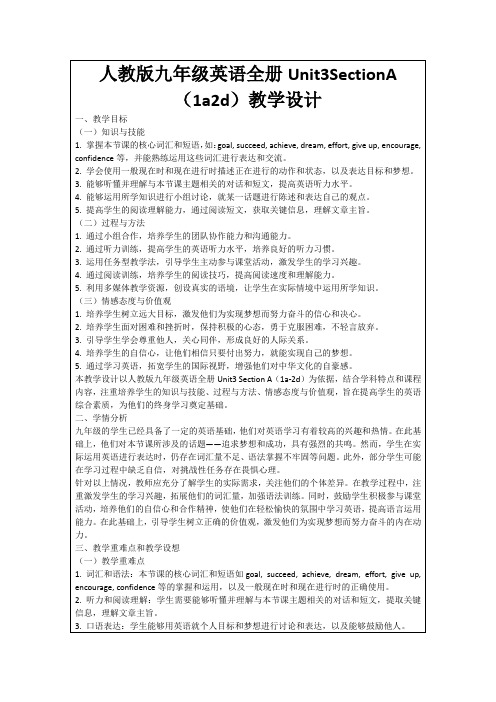
4.阅读拓展:推荐学生阅读一篇关于追求梦想的英文文章,提高阅读理解能力,拓展知识面。
5.课后反思:请学生反思本节课的学习过程,总结自己在词汇、语法、听力、口语等方面的进步和不足,并提出改进措施。
6.家庭作业:设计一份包括词汇、语法和阅读理解的综合练习,让学生在课后完成,巩固所学知识。
(三)情感态度与价值观
1.培养学生树立远大目标,激发他们为实现梦想而努力奋斗的信心和决心。
2.培养学生面对困难和挫折时,保持积极的心态,勇于克服困难,不轻言放弃。
3.引导学生学会尊重他人,关心同伴,形成良好的人际关系。
4.培养学生的自信心,让他们相信只要付出努力,就能实现自己的梦想。
5.通过学习英语,拓宽学生的国际视野,增强他们对中华文化的自豪感。
- What difficulties might you encounter on your way to achieving your dream? How will you overcome them?
- Can you think of some successful people who have achieved their dreams? What can we learn from them?
教师在布置作业时,要注意以下几点:
1.作业量要适中,避免过多导致学生负担过重。
2.作业难度要适中,既要具有一定的挑战性,又要确保学生能够独立完成。
3.鼓励学生发挥主观能动性,创新作业形式,如制作手抄报、录制口语视频等。
4.注重作业反馈,及时了解学生的学习情况,为下一步教学提供参考。
3.口语表达:学生能够用英语就个人目标和梦想进行讨论和表达,以及能够鼓励他人。
人教版九年级英语全册Unit3单元优秀教学案例

3.关注学生的情感态度和价值观,及时发现和纠正不良倾向。
4.根据学生表现,调整教学策略,提高教学效果。
四、教学内容与过程
(一)导入新课
在导入环节,我采用图片、歌曲、故事等多种方式,激发学生的学习兴趣,为新课内容的学习奠定基础。通过引导学生回顾已学知识,自然过渡到新课主题,帮助学生建立新旧知识之间的联系。
五、案例亮点
1.情境创设丰富多样:本案例通过图片、视频、音频等多媒体手段,以及实物、模型等教学道具,为学生提供了丰富的视觉和听觉信息,增强了课堂趣味性。同时,设计真实、生动的教学场景,让学生在实际语境中学习英语,提高了学习效果。
2.问题导向激发思考:本案例设计了富有挑战性的问题,引导学生主动发现和总结语言规律。通过提问、解答等方式,激发学生的思考和探究欲望,培养他们独立思考和解决问题的能力。
在教学过程中,我将注重激发学生的学习兴趣,通过引入贴近生活的话题和实例,引导学生主动探究和发现语言规律。同时,本案例还将强调团队合作和个性表达,鼓励学生在小组活动中共同解决问题,并在个人展示环节充分展示自己的才能。
在教学评价方面,我将采用形成性评价和终结性评价相结合的方式,关注学生的学习过程和成果。通过设置不同难度的任务,让所有学生在课堂上都能找到自己的位置,充分体现因材施教的原则。
4.利用实物、模型等教学道具,帮助学生直观地理解英语语法知识。
(二)问题导向
1.设计富有挑战性的问题,激发学生思考和探究欲望。2.通过提问、解答等方式,引导学生主动发现和总结语言规律。
3.鼓励学生提出问题,培养他们独立思考和解决问题的能力。
4.针对学生的困惑,提供有效的指导和方法,帮助他们克服学习难题。
Lesson 3 Thinking Skills anReading Strategies

➢ Look and say.
play Chinese yo-yo
1. Where is the girl ? In the park.
2. What is the weather like ? It’s sunny.
3. What is the girl doing ?
Time:
___________ ___________
Weather:
___________ ___________
➢ Activity 2
Read the text and complete the setting chart.
Many Americans love playing baseball. They play baseball all year long. On sunny or cloudy days, they play it outdoors. On rainy days, they play it indoors.
3. 在小组内交流个人喜欢的运动及运动小贴士,并请 同伴总结主要观点。
➢ Look and say.
The boy__is__ru_n__n_in_g__ .
Too short !
➢ Look and say.
• When is he running?
• At about half past two in the afternoon.
The setting of _p_l_a_y_in_g__b_a_s_e_b_all
Place:
o__u_t_d_o_o__rs__o_r i_n_d__o_o_r_s____
- 1、下载文档前请自行甄别文档内容的完整性,平台不提供额外的编辑、内容补充、找答案等附加服务。
- 2、"仅部分预览"的文档,不可在线预览部分如存在完整性等问题,可反馈申请退款(可完整预览的文档不适用该条件!)。
- 3、如文档侵犯您的权益,请联系客服反馈,我们会尽快为您处理(人工客服工作时间:9:00-18:30)。
8) How much time it would normally take to learn a particular element.
9) How objectives can be set and study plans made.
learner autonomy in the future.
1. Encourage students to be interdependent and to work collectively. The less students
depend on their teacher the more autonomy is being developed. Many students like
working in small groups and usually can be placed in pairs or small groups for various
exercises quite easily, that is, not against their wills. Pairs and groups can read dialogues
have learned.
13) What your strengths are in learning L2 in question.
14) What your weaknesses are in learning L2 in question.
15) How much time you are prepared to spend on your language learning per week.
4. Among others, you should consider the following questions:
1) What benefits and drawbacks learning a second language could have in general.
2) What benefits and drawbacks learning a particular language could have.
themselves to expand the limit of classroom learning.
What‘s more, independent learners will also develop independent personality. They
tend to be able to cope with other problems independently. This is an important quality
should consider your purpose, the methods to be adopted, the amount of time to be spent
on it per week, the problems trouble you would overcome come across in the course of
16) What resources you will need.
17) What kind of support you will need.
18) How you will keep your motivation up.
Etc.
5. Careful consideration of these questions helps you be more aware of your need. Therefore
5) For the purpose of one‘s study, what elements of the language need to be learned
and to what degree.
6) In what order these elements could be learned.
you will be a more conscious and efficient learner if you do as you are required in this
task.
6. By considering the criteria, you may know what is the proper way to plan and write a
learning, the method of learning, the timetable, the problems to overcome trouble to be
shot, and so on.
In the latter, you have to be responsible for the whole learning process yourself. You
task performed.
8. There is no hard and fast answer to this task.
9. There is no hard and fast answer to this task.
Home Assignment
The assignment is to engage students to experience learning as an autonomous learner. By
composition and eventually try to write it in a proper way.
7. It is important for you to have the interview questions ready beforehand with regard to the
7) have a tolerant tolerance of and outgoing approach to the target language and its
culture.
3. It is generally agreed that L2 learners should develop learner autonomy. Language
accuracy as well as appropriacy;
6) develop the target language into a separate reference system and are willing to revise
and reject hypotheses and rules that do not apply; and
you need for your ultimate goal is such a complex system that it is impossible to exhaust
a portion of it. In this connection, the learner should be able to learn on their own
In the former, you do not have to have an overall plan for your learning. The teacher
will do this for you. For example, the teacher will work out such things as the purpose of
Unit 3 Learner Autonomy
Aims and Objectives
After learning this unit, the students should know:
1. what is learner autonomy,
2. what are its features,
10) What the necessary resources are and where they are available.
11) What kind of language learner you are and how you learn.
12) How the learning of a particular item can be evaluated as you learn and after you
3) are willing to take risks, i.e., to communicate in the target language at all costs;
4) are good guessers;
5) attend to form as well as to content, and pay attention to that place importance on
learning is such a complex and enormous project. It is also time-consuming. Even if
classroom learning is available to you, it is impossible for the teacher to teach everything
3) What the nature of language and language learning is.
4) What are the language elements, if any, that need to be learned regardless of one‘s
purpose, and to what degree.
surfing on the internet, they will have a better understanding of how to be an autonomous
